1993 CHEVROLET CAMARO rear view mirror
[x] Cancel search: rear view mirrorPage 91 of 358
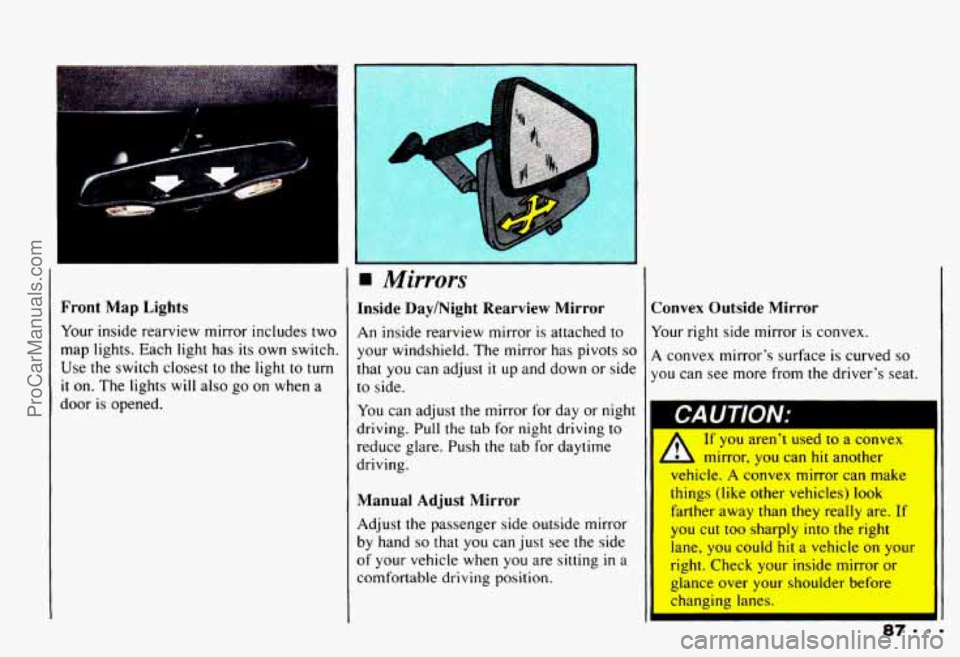
Front Map Lights
Your inside rearview mirror includes two
map lights. Each light has its own switch.
Use the switch closest to the light to
turn
it on. The lights will also go on when a
door is opened.
I
1
I'
. . . .. . .. . , . . .
Mirrors
Inside Day/Night Rearview Mirror
An inside rearview mirror is attached to
your windshield, The mirror has pivots
so
that you can adjust it up and down or side
to side.
You can adjust the mirror for day or night
driving. Pull the tab for
night driving to
reduce glare. Push the tab for daytime
driving.
Convex Outside Mirror
Your right side mirror is convex.
A convex mirror's surface is curvec so
you can see more from the driver's seat,
If you aren't used to a convex
L mirror, you can hit another
vehicle.
A convex mirror can make
things (like other vehicles) look
Manual Adjust Mirror
Adjust the passenger side outside mirror you cut too sharply into the right
by hand
so that you can just see the side lane, you could hit a vehicle on your
of your vehicle when you are sitting
in a right. Check your inside mirror or
comfortable driving position. glance over your shoulder before
farther
away than they really are.
If
changing lanes.
I
87.9-
ProCarManuals.com
Page 157 of 358
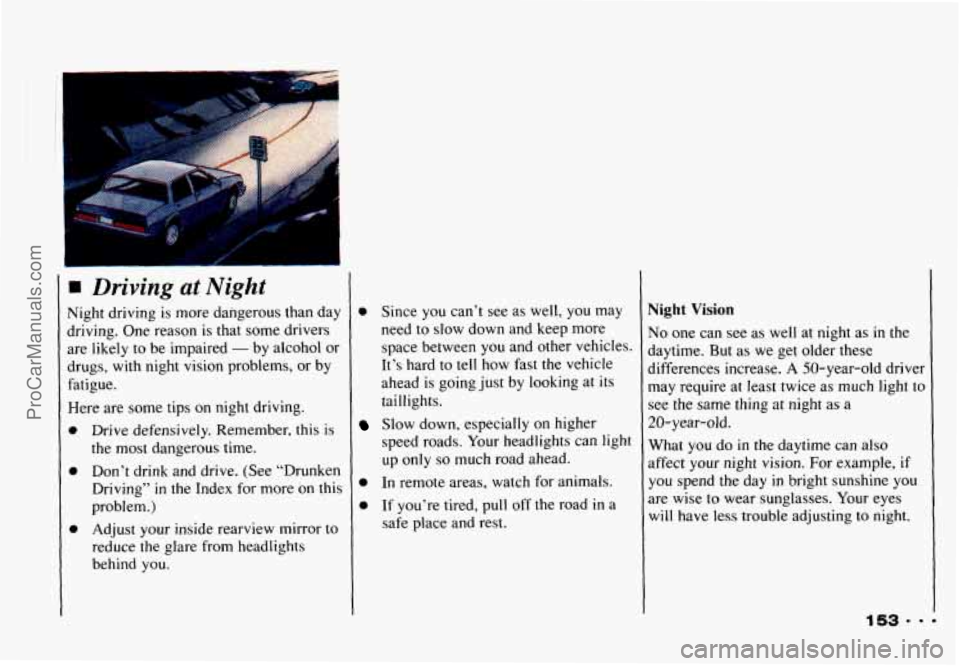
Driving at Night
Night driving is more dangerous than day
driving. One reason is that some drivers
are likely to be impaired
- by alcohol or
drugs, with night vision problems, or by
fatigue.
Here are some tips on night driving.
0
e
e
Drive defensively. Remember, this is
the most dangerous time.
Don’t drink and drive. (See “Drunken
Driving’’
in the Index for more on this
problem.)
Adjust your inside rearview mirror to
reduce
the glare from headlights
behind you.
0
0
0
Since you can’t see as well, you may
need to slow down and keep more
space between you and other vehicles.
It’s hard to tell how fast the vehicle
ahead is going just by looking at its
taillights.
Slow down, especially
on higher
speed roads. Your headlights can light
up only
so much road ahead.
In remote areas, watch for animals.
If you’re tired, pull off the road
in a
safe place and rest.
Night Vision
No one can see as well at night as in the
daytime. But as we get older these
differences increase. A 50-year-old driver
may require at least twice as much light to
see
the same thing at night as a
20-year-old.
What you do
in the daytime can also
affect your night vision. For example,
if
you spend the day in bright sunshine you
are wise to wear sunglasses. Your eyes
will have less trouble adjusting to night.
ProCarManuals.com
Page 165 of 358
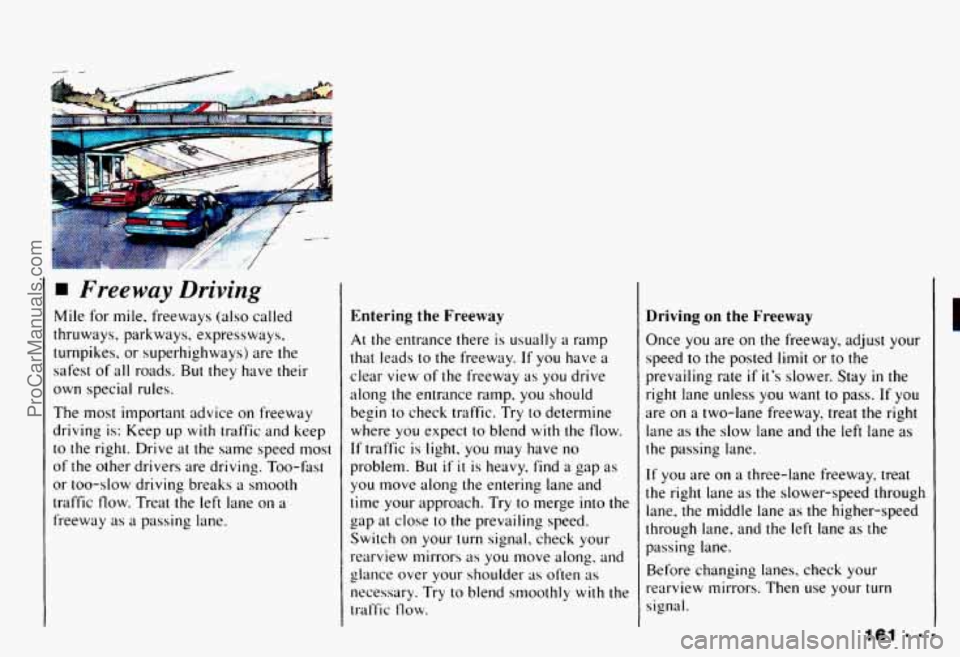
Freeway Driving
Mile for mile. freeways (also called
thruways, parkways, expressways,
turnpikes, or superhighways) are the
safest
of all roads. But they have their
own special rules.
The
most important advice on freeway
driving
is: Keep up with traffic and keep
to the right. Drive at the same speed most
of the other drivers are driving. Too-Past
or too-slow driving breaks a smooth
traffic flow. Treat the left lane on
a
freeway as a passing lane.
Entering the Freeway
At the entrance there is usually a ramp
that leads to the freeway.
If you have a
clear view of the freeway as you drive
along the entrance ramp, you should
begin
to check traffic. Try to determine
where
you expect to blend with the flow.
If traffic is light. you may have no
problem. But if it is heavy. find a gap as
you move along the entering lane and
time your approach. Try
to merge into the
gap
at close to the prevailing speed.
Switch on your
turn signal, check your
rearview mirrors
as you move along, and
glance over your shoulder as often as
necessary. Try
to blend smoothly with the
traffic flow.
Driving on the Freeway
Once you are on the freeway, adjust your
speed to the posted
limit or to the
prevailing rate
if it's slower. Stay in the
right lane unless
you want to pass. If you
are on a two-lane freeway, treat the right
lane as the
slow lane and the left lane as
the passing lane.
If you are on a three-lane freeway, treat
the right lane as the slower-speed through
lane, the middle lane as the higher-speed
through lane, and the left lane as the
passing lane.
Before changing lanes, check your
rearview mirrors. Then use your turn
signal.
I
ProCarManuals.com
Page 169 of 358
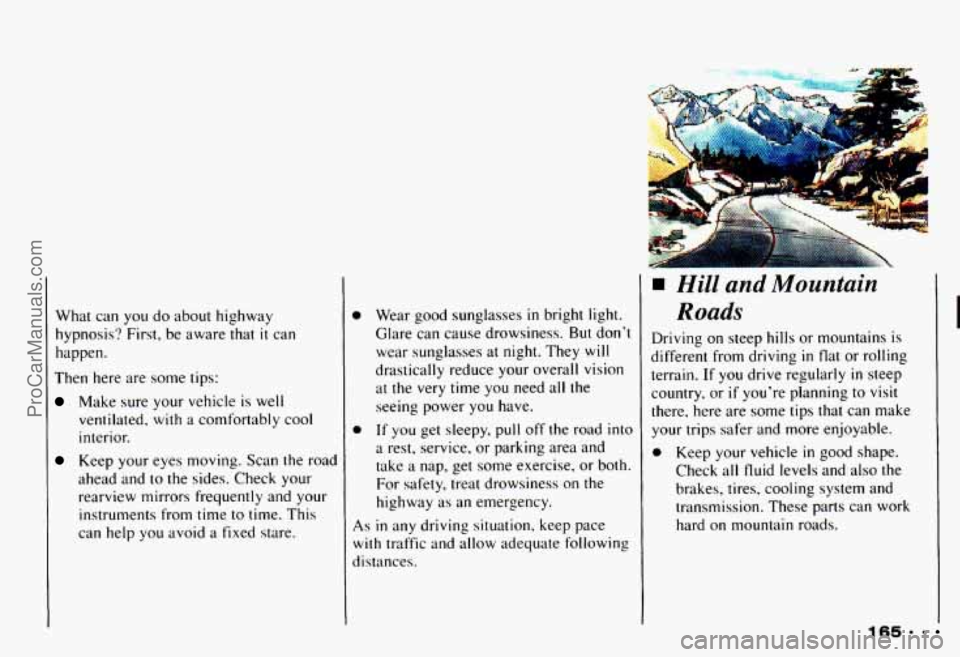
What can you do about highway
hypnosis'? First, be aware that
it can
happen.
Then here are some tips:
Make sure your vehicle is well
ventilated,
with a comfortably cool
interior.
Keep your eyes moving. Scan the road
ahead and
to the sides. Check your
rearview mirrors frequently and your
instruments from time
to time. This
can help you avoid a fixed stare. Wear
good sunglasses
in bright light.
Glare can cause drowsiness.
But don't
wear sunglasses
at night. They will
drastically reduce your overall vision
at
the very time you need all the
seeing power you have.
If you get sleepy,
pull off the road into
a rest, service, or parking area and
take a nap, get some exercise, or both.
For safety, treat drowsiness on the
highway as an emergency.
As in any driving situation. keep pace
with traffic and allow adequate following
distances.
Hill and Mountain
Roads
Driving on steep hills or mountains is
different from driving
in flat or rolling
terrain. If you drive regularly
in steep
country. or
if you're planning to visit
there, here are some tips that can make
your trips safer and more enjoyable.
0 Keep your vehicle in good shape.
Check all fluid levels and also the
brakes, tires, cooling system and
transmission. These parts can work
hard on mountain roads.
1659 *
ProCarManuals.com
Page 281 of 358
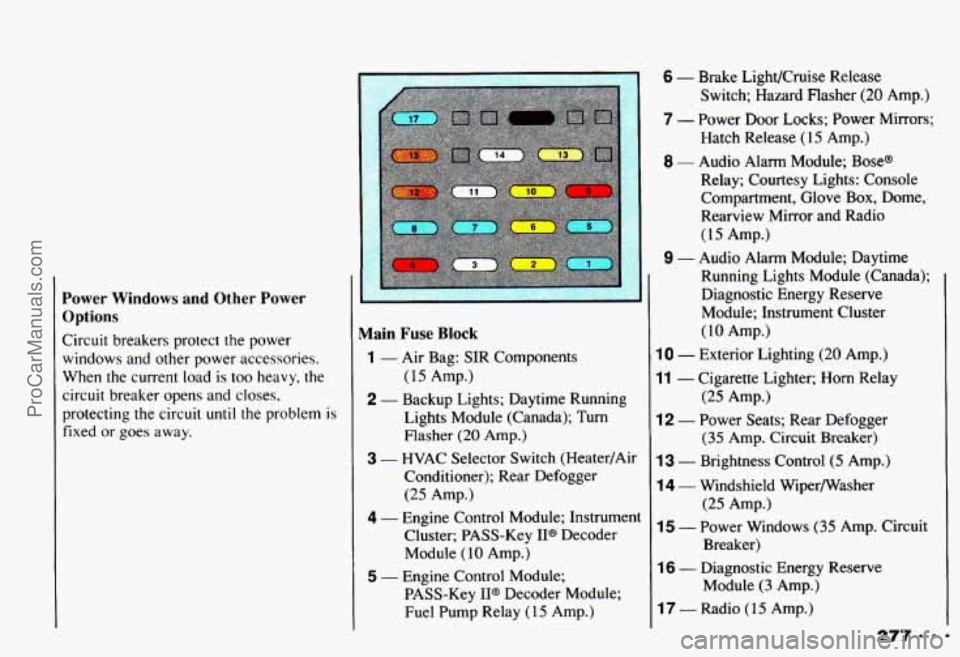
Power Windows and Other Power
Options
Circuit breakers protect the power
windows and other power accessories.
When the current load is
too heavy, the
circuit breaker opens and closes,
protecting the circuit
until the problem is
fixed or goes away.
Main Fuse Block
(15 Amp.)
Lights Module (Canada); Turn Flasher
(20 Amp.)
3 - HVAC Selector Switch (Heater/Air
Conditioner); Rear Defogger
(25 Amp.)
4 - Engine Control Module; Instrument Cluster; PASS-Key IP Decoder
Module
( 10 Amp.)
1 - Air Bag: SIR Components
2 - Backup Lights; Daytime Running
I
5 - Engine Control Module; PASS-Key
II@ Decoder Module;
Fuel Pump Relay
(1 5 Amp.)
6 - Brake LighVCruise Release
Switch; Hazard Flasher
(20 Amp.)
7 - Power Door Locks; Power Mirrors; Hatch Release (15 Amp.)
8 - Audio Alarm Module; Base@
Relay; Courtesy Lights: Console
Compartment, Glove Box, Dome,
Rearview Mirror and Radio
(15 Amp.)
9 - Audio Alarm Module; Daytime
Running Lights Module (Canada); Diagnostic Energy Reserve
Module; Instrument Cluster
(10 Amp.)
10 - Exterior Lighting (20 Amp.)
11 - Cigarette Lighter; Horn Relay
12 - Power Seats; Rear Defogger
13 - Brightness Control (5 Amp.)
14 - Windshield Wipermasher
15 - Power Windows (35 Amp. Circuit
(25 Amp.)
(35 Amp. Circuit Breaker)
(25 Amp.)
Breaker)
16 - Diagnostic Energy Reserve Module
(3 Amp.)
17 - Radio (15 Amp.)
ProCarManuals.com
Page 341 of 358

Main Fuse Block ............. 277
Main Light Control ............. 85
Inspections. Periodic ......... 303
Maintenance
Materials. Appearance Care and
................. 274
Record .................... 308
Schedule ................... 285
Services. Scheduled .......... 289
When Trailer Towing ......... 18 1
Malfunction Indicator Lamp ..... 103
Manual
Four-Way Seat
............... 12
Front Seat ................... 12
Remote Control Mirror ........ 88
Making Turns (With a Trailer) .... 178
Transmission (Five-Speed) ..... 66
Transmission (Six-Speed) ...... 67
Transmission Fluid ........... 235
Windows ................... 75
Map Lights. Front .............. 87
MapPocket ................... 92
Markings. Pavement ........... 135
Master Cylinder. Brake ......... 244
Mirrors ....................... 87
Convex Outside .............. 87
Electric Control .............. 88
Inside Daymight Rearview ..... 87
Manual Remote Control ........ 88
Visor Vanity. Covered ......... 94
Manual Adjust ............... 87
New Vehicle “Break-In’’ ....... 55
Night
Driving at
.................. 153
Driving Suggestions. A Few
More
.................... 155
Vision ..................... 153
Odometer. Speedometer and ..... 98
Odometer. Trip ................. 99
Off-Road Recovery ............ 149
Officer. Traffic ................ 136
Oil. Engine ................... 226
Operation of Lights ............. 84
Overheating. Engine ........... 193
Owner Checks and Services ...... 298
337 9 9 9
I
ProCarManuals.com